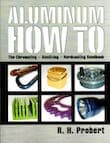
-----
Excess dye on surface of anodized parts
Q. I have machined parts made from 7075-T651 aluminum coming back from my local anodizer after Type II Class II anodizing with excess dye on all surfaces of the parts. The excess dye can be wiped away with a microfiber cloth wetted with vinegar (4% acetic acid) and once the excess dye is wiped away the anodized layer underneath looks pristine and has no visible changes to its color or finish. Excess dye is seen with all dye colors except the gold which I believe is a FAO based dye. Anodizer uses a mid temperature nickel free seal.
Any recommendations for process changes to prevent the excess dye or post anodizing cleaning solutions to wash away the excess dye are welcome.
- Calgary Alberta Canada
April 26, 2025

Aluminum How-To
"Chromating - Anodizing - Hardcoating"
by Robert Probert
Also available in Spanish
You'll love this book. Finishing.com has sold almost a thousand copies without a single return request :-)
A. Scott
There are numerous reasons excess dye accumulates on parts. One of the first is excessive coating thickness. 7075 material gains thickness very quickly which can contribute to the excessive dye appearance in what is affectionately called smut. Yes, while the extra dye is being wiped away and giving the appearance of a clean part, make no mistake, if parts are smutty, good chance the coating is soft and compromised to some degree due to a higher thickness.
Your parts only look pretty but the coating may not have the full integrity it should.
Another reason for smut is when excessive amount of salts accumulate in the dye. This is especially noticeable with black dye. Salts will generally float to the top as the tank cools giving the appearance of chocolate floating on top of the tank. But guess what? When those salts are not floating atop the dye, they are suspended in the tank because of the air agitation in the tank. They are waiting to affix themselves to the unsuspecting parts being introduced into the bath
I also recall in my days parts entering the seal tank looking pristine but exiting looking smutty. There are probably numerous other technical reasons for smut but i have only addressed a few. I would not recommend wiping the parts with vinegar or acetic acid as this can have the tendency to compromise the seal. (Windex with vinegar is not a good idea when cleaning anodized parts.) a scotch brite pad and even a soft buffing wheel are better options.
retired - Newport, Tennessee
Q, A, or Comment on THIS thread -or- Start a NEW Thread
